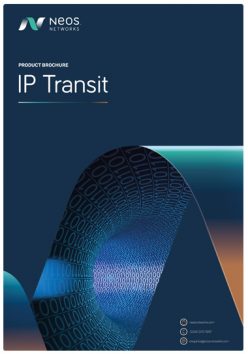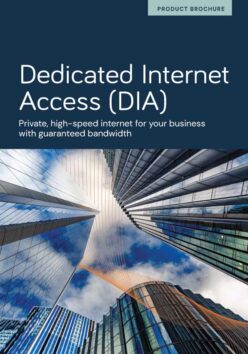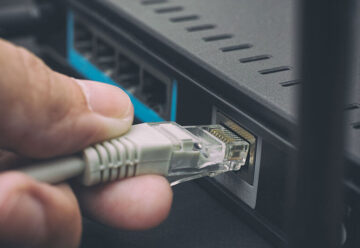High-performance
IP Transit services
What is IP transit?
IP transit, or internet transit, is a service offered by internet service providers (ISPs) that enables other ISPs or large enterprises to connect to the internet. It allows network traffic to transit through the provider's network to larger networks, giving access to the entire global internet.
If you’re a medium to large enterprise, you’ll likely choose either IP transit or Dedicated Internet Access (DIA) to connect directly to the internet.
IP transit vs DIA
Dedicated Internet Access (DIA) is a high-speed, dedicated connection between your business and the internet with guaranteed fixed bandwidth and symmetric upload/download speeds. Businesses that need a private, reliable internet connection commonly use DIA for their critical networks.
By contrast, IP transit provides internet access by allowing data transmission through multiple paths across the public internet, so the service is affected by internet traffic. ISPs, telecom companies, data centre providers or other large enterprises typically use IP transit to deliver broad internet connectivity to their staff and end users.
While DIA uses a leased line that can be set up at any enterprise premises, IP transit connects through data centres because it works differently.
How does IP transit work?
IP transit works at the level of backbone networks using a protocol called Border Gateway Protocol (BGP).
The internet is a global network of interconnected public networks known as autonomous systems (AS), which use BGP to direct traffic between them. Each AS is assigned a unique Autonomous System Number (ASN) to identify them on the network and blocks of IP addresses to identify their network devices.
If you’re a large organisation with your own ASN and IP addresses, you can connect to an IP transit provider’s network using BGP. Put simply, you pay a provider to access their network, opening up high capacity access to the whole internet.
Simplified IP transit connection
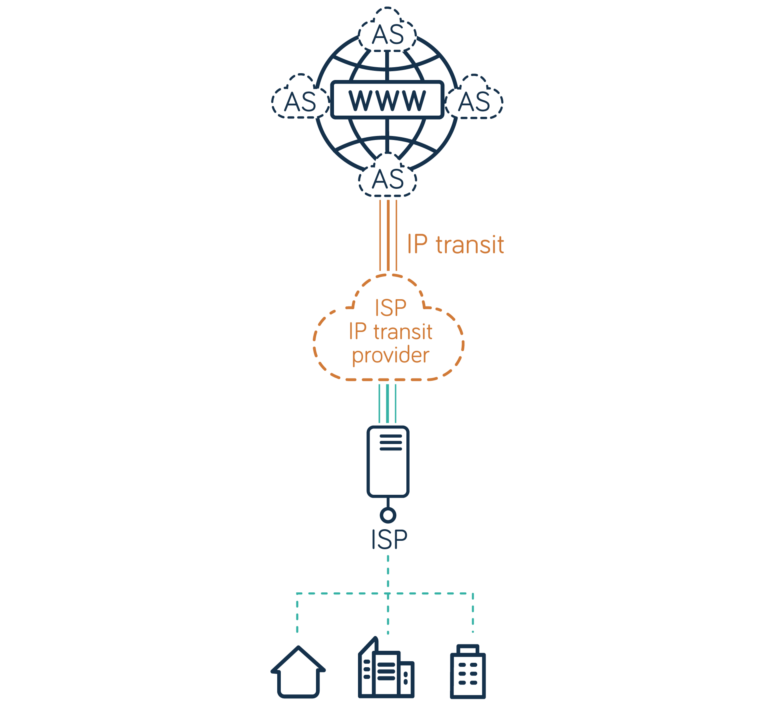
IP transit vs peering
Another way for an ISP to connect to another ISP is through IP peering, which can be either public or private:
- Public peering is when different networks exchange internet traffic at a shared location, like an internet exchange point (IXP); this typically incurs costs.
- Private peering is when two networks agree to a mutual exchange of data free of charge. There’s no fee because the amount of data shared from both sides is usually equal, so both benefit equally.
In contrast, IP transit is a paid exchange of data between two ISPs. The organisation being paid is ‘upstream’ of the one paying, meaning that it’s higher up in the ISP hierarchy and offers access to the entire global internet.
IP transit tiers
In the hierarchy of IP transit providers, ISPs are divided into three tiers depending on their scale and reach.
Tier 1
Tier 1 providers have global reach and can access the whole internet without the need to use IP transit or peer with other providers. Their focus is on providing the global internet backbone. Tier 1 includes giants like Verizon and Cogent Communications.
Tier 2
Tier 2 providers have large networks with regional, national or international reach. They may peer with other Tier 2 providers as well as Tier 1 providers to interconnect with the global internet backbone. Among Tier 2 providers are Neos Networks, Sky and BT Wholesale.
Tier 3
At the regional level, Tier 3 comprises local providers that buy IP transit services from upstream Tier 2 or Tier 1 providers. They typically deliver internet access to business and consumer users in a local area. In the UK, Tier 3 includes providers like Andrews & Arnold, Community Fibre and Hyperoptic.
Good IP transit providers use extensive Tier 1 and Tier 2 peering. This not only enhances route resilience, but also reduces the number of ‘hops’ in your connection to the global internet, helping to reduce latency and costs.
IP transit pricing
Pricing for IP transit services depends on the provider and may be based on metered usage, flat-rate billing or tiered depending on the bandwidth used:
- Bandwidth usage: Metered usage is measured per megabit per second (Mbps). It employs the 95th percentile billing methodology, so called because the top 5% of usage is not billed. The method measures the billed usage every five minutes.
- Flat-rate billing: If you anticipate large traffic volumes over a prolonged period, a flat-rate plan could be best for your business. You’ll be charged for the bandwidth you commit to using. Typically, the higher the commitment, the lower the per Mbps pricing.
- Tiered pricing: Tiered pricing is based on using a specific bandwidth. If you use more bandwidth, you move up to the next tier, incurring a lower flat rate.
As usual, longer contract terms typically mean discounted rates compared to short-term or monthly agreements.
High-performance
IP Transit services
Single-homed vs multi-homed IP transit
IP transit can be divided into two basic categories depending on how they connect to ISPs.
Single-homed IP transit
Single-homed IP transit connects you to the internet via a single ISP. While it’s the cheapest and simplest configuration, it’s also the least resilient. If the single link fails, you lose your internet connection. You’re also limited by the capacity of that ISP.
Single-homed IP transit example

Multi-homed IP transit
With multi-homed IP transit, you have multiple ISP connections. Multi-homed connections are generally more expensive than single-homed ones, but they’re more resilient and reliable. If one link or ISP goes down, another takes over. You can also optimise traffic and balance loads across multiple connections.
Multi-homed IP transit example
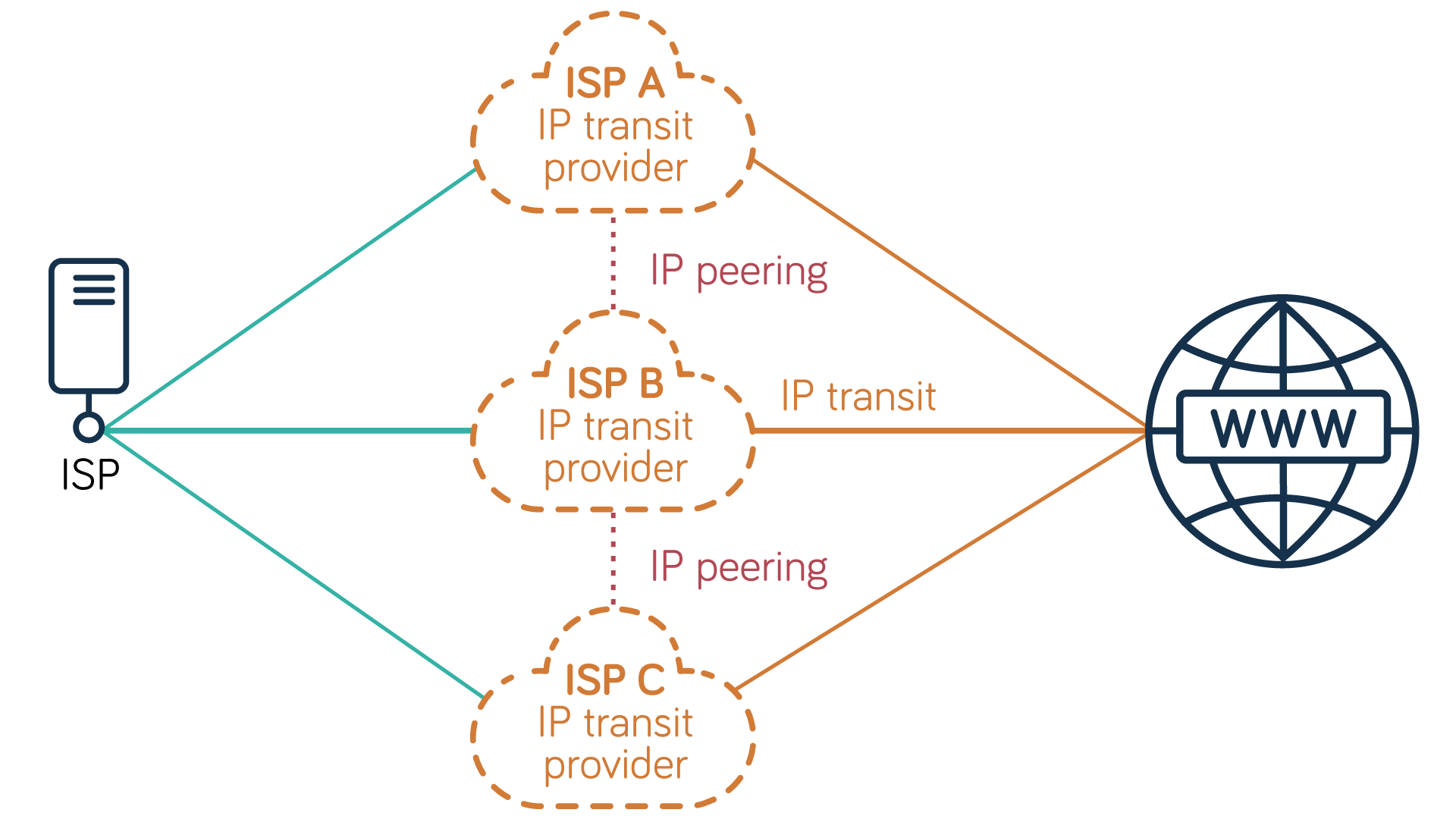
IP transit vs transport
IP transit is sometimes confused with IP transport, but they’re different. While IP transit refers to connecting ISPs to wider networks, IP transport is about the physical transmission of data. It refers to the protocols and services used to transmit data point to point on dedicated or shared network infrastructure.
Choosing an IP transit provider
If your business needs IP transit services, choosing the right provider is vital to ensuring reliable internet connectivity.
Apart from ensuring the pricing and billing meet your needs, you’ll need to consider the provider’s network reach, reliability, scalability and global peering. Does the provider have a proven track record of reliability and performance?
At Neos Networks, we provide resilient, scalable, cost-effective IP Transit for large enterprises and ISPs across the UK, including:
- UK-wide high capacity network built for Critical National Infrastructure
- Over 90 on-net data centres to connect nationwide
- Multi-homed platform with extensive Tier 1 IP peering
- 24/7/365 technical support from our UK-based network operations centre (NOC)
To learn more about our IP Transit services, download the brochure.
High-performance
IP Transit services
If you’d like to discuss which IP Transit service is best for you, get in touch. We’ll be happy to make IP Transit work for your business.



